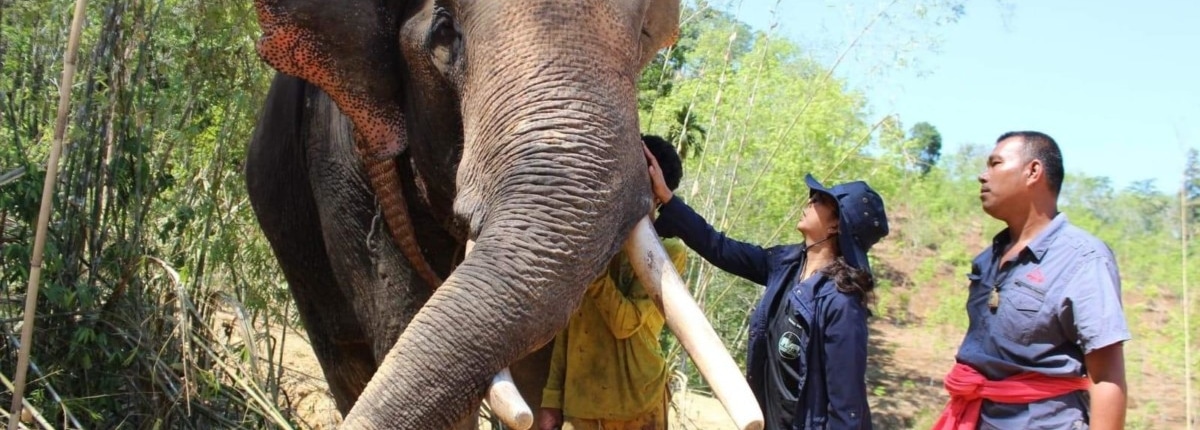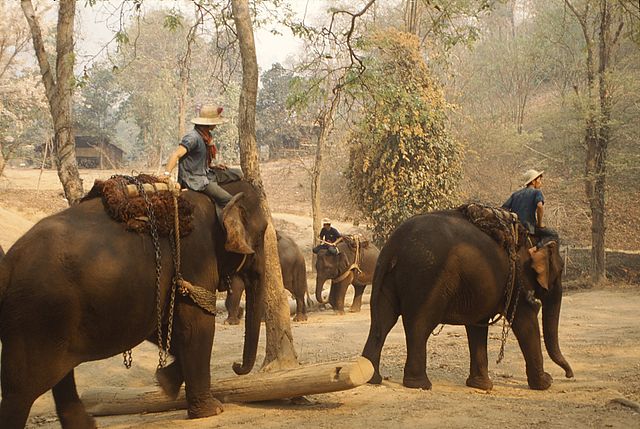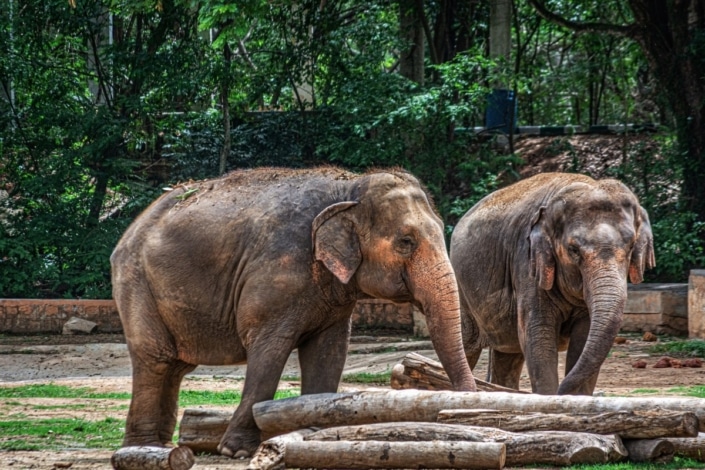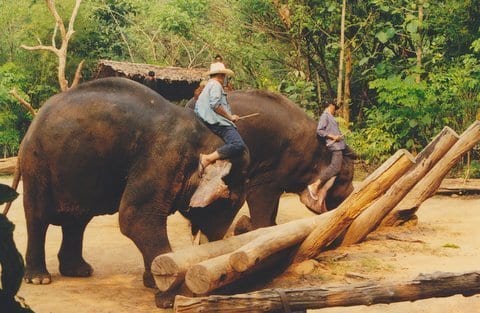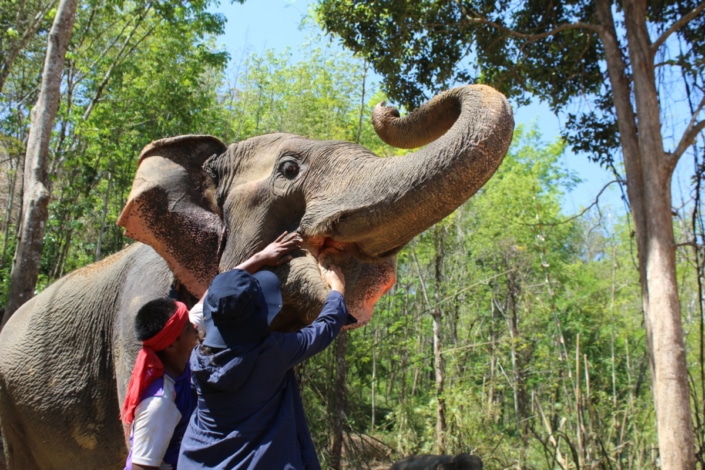Logging in Thailand – A Brief History
Now mostly banned in Thailand, logging was once a way of life for thousands of elephants.
The life of a logging elephant in Thailand was tough, hard work and sometimes cruel, but perhaps the greatest tragedy of all is that the elephants that worked in the logging industry unwittingly contributed to the decline of their own species. Deforestation, particularly in the most heavily forested Thai Highlands region of northern Thailand, has had a major impact on the country’s elephant population to the extent that Asian elephants are now classified as an endangered species.
In the early 1900s there were around 100,000 domesticated elephants in Thailand used not just for logging but also for transportation, bridge building and other construction work. It is difficult to know accurately how many wild elephants there were at this time, but by all accounts, at least double that number. Since then, the number of domesticated elephants has dwindled to around 3,700 and the number of wild elephants is even smaller. In the same period, Thailand’s human population has increased tenfold.
Logging began in earnest at the end of the 1800s when both the French and British sought logging rights in Thailand for teak wood which was needed for ship building because the European forests had become almost depleted of oak. Although some 70 years later all foreign logging licenses were revoked, there continued to be much pressure on Thailand’s forests for agricultural clearance to feed the country’s growing population. Forests went on being destroyed up until 1989 when general logging was made illegal, a decision taken largely as a result of catastrophic flooding the previous year, but also because of the realisation that there was now very little virgin forest left in Thailand. These days the only logging with elephants that takes place legally in Thailand is carried out by government licensed logging camps either to remove illegally harvested teak wood in remote locations or to clear old plantations where vehicle access is impossible.
In its heyday, logging was often poorly regulated with little control over the business practices of the British, Thai and Chinese timber firms that operated in the region. Most of the work was carried out in natural forests and jungle where the terrain was impregnable to heavy machinery, so elephants became both an important means of transport and an essential part of the logging process. The size, strength, longevity and remarkable intelligence of these magnificent creatures, and their knowledge and understanding of their own jungle environment, made them invaluable to the logging industry.
Elephants would begin training for logging work at around the age of 3 to 5 years. It was a long and careful training process to ensure the elephants would form a strong bond with their mahout and learn the intricacies of their job, without becoming a danger to those working with them. First, they would be taught the commands for walk, stop, crouch down, pick up, move, lift, pull and push. Then they would learn how to haul the logs to the nearest river, where they would stack them in piles to await the monsoon rains. Once the rivers became swollen with water, the logs could be floated downstream to the nearest sawmill – often all the way to Bangkok.
Conditions for the elephants in the logging camps depended on the company they were with, but the work was nearly always hard, hot and sometimes dangerous, as indeed it was for the men who worked with them. As described in the book, Elephant Company [1], “The men, using only axes and simple saws, with blades two inches across, would dispatch teak trees that were often over 100ft tall and 9ft in girth…. The big, experienced elephants would then transport the massive, two-ton logs from stump to stream. Drag chains were attached to the elephant’s’ nine-inch-wide plaited breast bands, and then run up and over a wooden saddle (padded underneath with thick layers of woven bark). Logs twenty to thirty feet in length and about seven feet in girth could be hauled by a single elephant, with bigger logs requiring teams of two or three elephants…..the men were also fearless, often darting in between the legs of the tuskers to free snagged chains”. The better logging camps would allow their elephants plenty of rest, and at night would leave them free to roam and feed in the jungle. Given that it took time and investment to train their elephants, it was in a company’s best interests to look after such valuable assets.
When logging was officially banned in 1989 it was the final blow for Thailand’s domesticated elephants. Not only had they helped to destroy much of Thailand’s natural forestry – their own habitat – but now they were out of a job. Furthermore, desperate elephant owners and mahouts were left to find a way to pay for their elephant’s keep. What do you do with a four- or five-tonne elephant that can no longer work for a living but eats up to 300kg of vegetation a day? Unfortunately, releasing a domesticated elephant into what little jungle is now left in Thailand is not really an option, as the elephant won’t know how to look after itself, having spent all its life being cared for by humans. Furthermore, attempts to return domesticated elephants to the wild often result in greater human/elephant conflicts when roaming elephants trample farmland and ruin crops in their pursuit of food.
Thailand has a land area and population size similar to the UK; there are no longer vast forests where elephants can simply “return to the wild”. In 1950, shortly before all foreign logging licenses ended, approximately 70% of Thailand’s country was still forested. Now, due to a growing human population and increased demand for agricultural land, only 25% of that forested land remains. Elephants in Asia have been domesticated for centuries, and they are deeply embedded in Thailand’s culture. The problems surrounding their future are both complex and emotive.
These days it is the tourist industry, rather than the logging industry, which provides the opportunity for owners to earn enough money to feed and care for their elephants. Given that elephants can live to about 80 years old, some of the elephants now in Thailand’s tourist parks were probably once in the logging industry. Whatever an elephant’s circumstances, at STEF our main objective is to provide veterinary treatment and care to any elephant in need.
[1] Elephant Company by Vicki Constantine Croke
[Click on photos below to enlarge and read captions]

